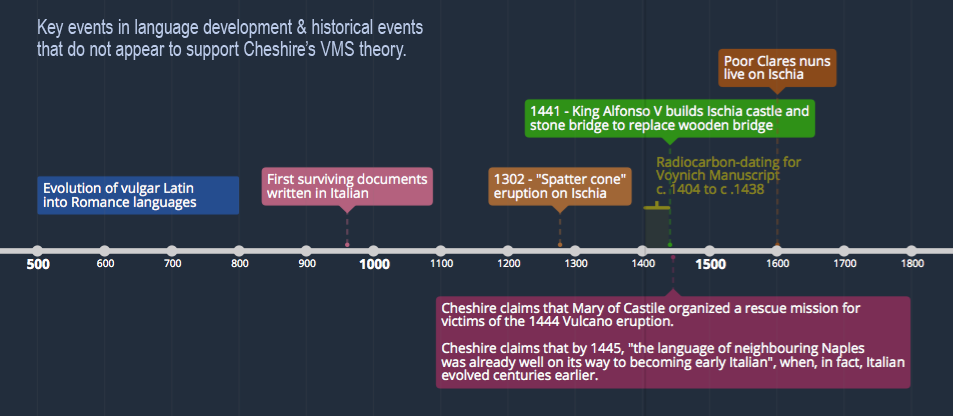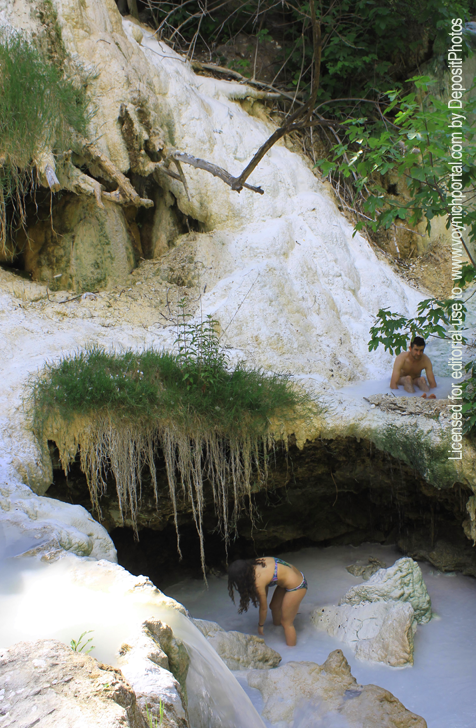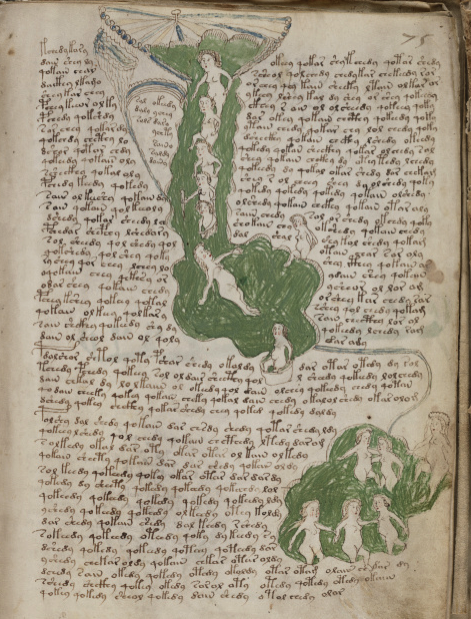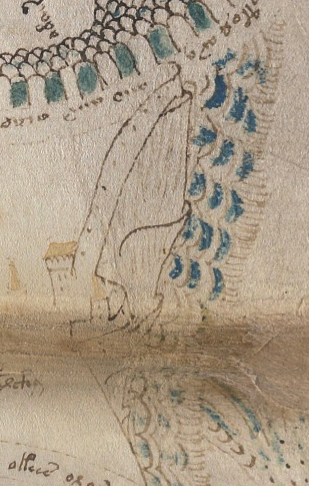20 May 2019
I am fond of pyrotechnics and once kayaked out to see a giant fireworks display raining flames on the water.
It was risky. Powerboats with drunk pilots whooshed around me in the dark. To add to the adrenaline, sparks were landing on my shoulders and pfushed and sizzled against the kayak. They could have ignited my clothing or hair… but I loved the front-row seat.
If you can’t resist fireworks, imagine squinting into the middle of a diamond-studded vortex, sparks exploding all around you, with 8-foot swells lifting the boat closer to the blast. It’s awesome.
So it’s natural for me to want to find volcanoes in the VMS “map”. I’ve mentioned volcanoes numerous times on my blog and on the forum, have admitted that the Naples area is on my top-5 list of locations for the VMS “map” (it’s not my only idea, but it was the first region I studied in depth after a long investigation of the water-gardens at the villa d’Este). Recently, I wrote in more detail about volcanoes and mud vents.
Historical Precedent
The idea of volcanoes on the “map” foldout is not new. I took it for granted that many people probably saw them as volcanoes. A quick Google search as I was writing this blog brought up volcano references from 1996 and there are surely some older than that, considering there’s more than one rotum that could be interpreted as a volcano.
Rotum1 (top-left circle) looks like a mountain or gaping maw. Rotum7 (bottom-left), could be flows of water, but could also be flows of lava.
Similarly there are spewy mounds between the rota that might represent volcanoes or mud vents, but they might also be geysers or natural springs.
I’ve suggested Rotum3 might be the remains of a volcanic crater (e.g., the island of Nisida, which has a small crater-shaped harbor facing the sea, with remains of an ancient castle wall on the ridge).
I’ve also mentioned Vesuvius, the island of Sicily, and volcanic areas around Damascus, Azerbaijan, and the region around Ischia. Even though there are numerous possibilities, Naples is one of my favorites because it has ancient pools that potentially connect volcanic “hot spots” with thermal bathing.
Eruptions in the 14th and 15th Centuries
In 1302, there was a “spatter cone” eruption on Ischia (you can see a debris field to the lower right on this old map labeled “Locus terribilis…”):
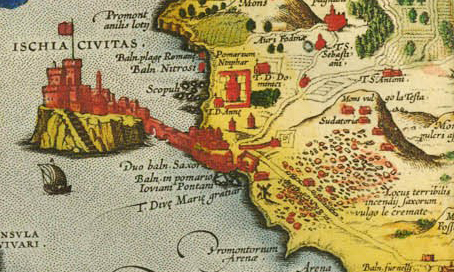
In 1329, 1333, and 1381 Abraham Rees describes major eruptions of Mt. Etna. These kinds of events could have been handed down as oral or written history to the creator of the Voynich Manuscript. But are they reflected in the VMS “map”?
Cheshire One More Time (and Hopefully the Last)
Gerard Cheshire has based his entire “proto-Romance” linguistics solution around this very premise. In his recent paper he claims the VMS “map” documents a heroic rescue from a volcanic eruption.
In the previous two blogs, I commented on the linguistic flaws in his arguments. In this blog, I’ll quickly summarize his historical assertions.
Cheshire contends that nuns in the Castello Aragonese, off Ischia, wrote the VMS, and that the “map” documents the rescue from a 1444 eruption of Vulcano (in the Aeolian islands).
Other than the eruption, these ideas don’t seem to be supported by facts, …
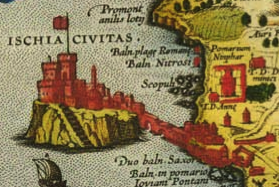
I’ll continue looking, but I haven’t found any evidence that nuns lived on Ischia prior to c. 1600 or that they lived in King Alfonso’s Castello in the 15th century as Cheshire claims. The castle was built in 1441 just off Ischia, as shown in the diagram on the right. Cheshire writes that this is where the VMS originated.
The following timeline shows some key events related to Cheshire’s theory that appear to be at odds with his claims:
Cheshire says that Maria of Castile organized a rescue from an eruption of Vulcano. The only rescue mission I came across was the liberation of Alfonso and his brother when they were captured in Naples. If any historian has evidence that Maria of Castile ferried victims away from a volcanic eruption in 1444, feel free to comment below.
As much as I like the idea, the interpretation of the VMS map as one or more volcanoes is problematic when applied to the Naples area. There are two sets of Ghibelline merlons on the VMS “map” that don’t mesh well with Naples. In the mid-15th century, this style of battlement was mostly confined to parts of what we now call northern Italy. For this reason, I have never committed fully to Naples and have continued researching the other possibilities on my list…
Lava and Lavage
Let’s assume for a moment that the various vents and flows on the VMS “map” are streams and sources of water, which may or may not have a volcanic source…
One of my other favored locations is an area with numerous hot springs, including Bagni San Filippo, Bagnore, and Saturnia.
Of particular interest are the natural spring areas of Tuscany, such as San Filippo, where thermal pools, dripping foliage, and calciferous stalactite formations are nestled in a picturesque setting of rivers and woods—just the thing to inspire drawings of nymphly bathing and grotto-like archways and caves.
Some of the pools have calciferous walls that hold the water in step-like terraces. Others are ringed with stone walls that have been built and rebuilt for thousands of years.
Some pools appear bright blue, others green.
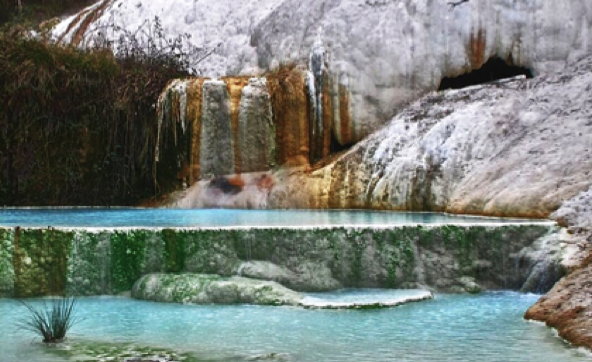
Numerous waterfalls carve pathways through the rocks to feed the step formations:
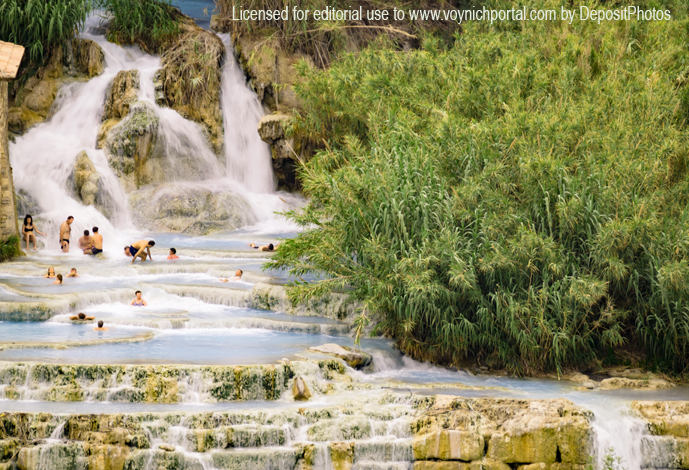
This by itself is not enough to connect San Filippo, Saturnia, or Monticiano hot springs with the VMS. There are thousands of hot springs throughout Europe, in Turkey, Germany, eastern Europe, several regions of Italy, and Sicily.
What interests me about the hot springs in Tuscany is that they are near a stronghold for Ghibelline sympathizers, which might explain the swallowtail merlons:
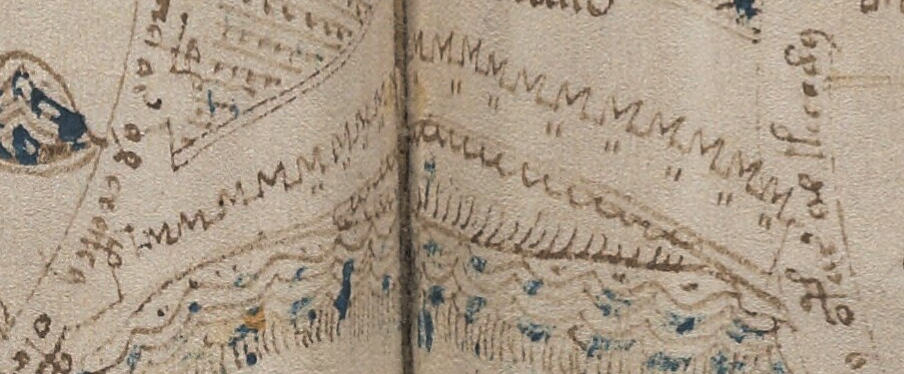
Some people have suggested that the VMS pools might be color-coded for fresh or salt water. I think this is possible, especially if the pools represent something less literal than bathing pools. But, if they are bathing pools, maybe the colors represent hot or cold water. It was believed (and still is) that alternating between different temperatures can be therapeutic.
It was also believed that pools with certain temperatures and mineral balances were good for particular parts of the body, which might explain some of the drawings in the “bio” section. There’s no guarantee the different sections of the VMS relate to each other, but I’m hoping they do, because a holistic approach, on the part of the designer, appeals to me.
Moon-Shaped Medieval Castles
If the “stars” on Rotum3 (upper-right) are meant to represent water, then it’s possible it is a moon-shaped island with a castle at the top. It’s one of the reasons I think it could be an island in the Naples area. There are several crater-shaped islands, including Nisida.
In Greece, Santorini is similar (I’ve been there and if you scramble up Mesa Vuono mountain, you get a real sense of the vastness of the crater).
But if the “map” represents Tuscany, where would you find a moon-shaped island? This might be a bit of a stretch, but this 1664 map of Elba, an island off the coast of Tuscany, has a very interesting drawing of a moon-shaped castle-complex labeled Cosmopoli, with a man-made bridge connecting it to Elba. It’s not on a steep hill, like Nisida, but at least it has some of the characteristics of Rotum3:
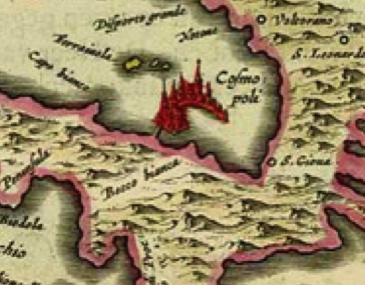
Rotum3 isn’t necessarily an island, it might just be a stopping point on a strip map, but if it is an island, there are a few locations that could account for its distinctive shape.
Along the Pathway
There’s another detail on the VMS map that can relate to Tuscany… on the pathway between Rotum2 and Rotum3 are some undulating ledges that look somewhat like dunes, possibly sand dunes.
If you turn them, however, so that the tower and wall are facing up, then they look more like solid escarpments.
They’re too steep and narrow to be vineyards, but they reminded me of something, something I couldn’t put my finger on at first…
Then one morning I woke up and remembered—marble quarries, the mountains of Carrara, pathways and ledges.
Here’s a photo…
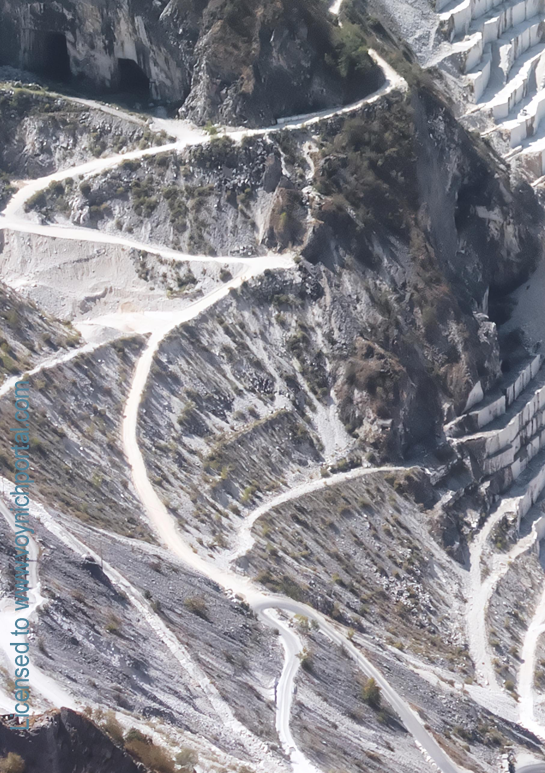
Note the textural differences between the paths winding up into the mountains and the escarpments where the marble has been quarried in stepwise fashion.
We don’t know exactly how the quarry looked in the middle ages, but the mountains have been mined for hundreds of years, supplying marble for pillars, walls, mosaics, and classical statues that grace ancient buildings. Now marble is used largely for floor tiles and countertops.
It’s not a perfect match for the VMS drawing, but it does have a similar feeling, so maybe the “dunes” represent some pathway through mountains.
Summary
I can’t possibly cover every detail of the map in one blog, this is enough for now. Much of this I’ve mentioned before, but it illustrates that there are many ways to interpret the “map”, more of which I’ll cover in future blogs.
J.K. Petersen
© Copyright 2019 J.K. Petersen, All Rights Reserved

